Free Surgery Clinic
In 2007, The Sam Simon Foundation began offering a wide variety of free surgeries, such as mass removals, amputations, and bladder stones.
The Sam Simon Foundation accommodates requests based on the level of urgency of each request, and not on the order in which they are received. For example, certain ailments such as cherry eye may have to wait a year or more to get in, while others, such as pyometra, are scheduled immediately.
Depending on the ailment, you may be required to bring your pet in for a pre-exam at our clinic, at which time a physical exam will be given and the urgency level of the ailment recorded. Exams are only scheduled if we anticipate that we will be performing surgery on your pet. We do NOT offer general exams.
All non-spay/neuter surgeries performed by the foundation require a minimum of two follow-up visits. In an effort to remain accessible to our clients from week to week, each location is typically scheduled only 2-5 miles from the previous location.
For a list of locations, click here.
All surgeries are performed at our doctor’s discretion. E-collars, appropriate bandaging, pain medication, antibiotics, after-care instructions, and follow-up exams are included with surgeries performed by The Sam Simon Foundation.
Current Calendar
Download this month's calendar
Next Month's Calendar
Download next month's calendar
Dates & Locations
Download our dates and locations
Missed appointments are not rescheduled.
Do my pet and I qualify?
For major surgeries, we do not have a minimum or maximum age or weight requirement. Rather, the pet’s eligibility is determined on a case-by-case basis.
The only qualification for services is that your total household income must be less than $40,000 per year.
Acceptable proofs of income:
- Current tax returns
- Proof of government aid, such as (but not limited to): WIC, GR, CalFresh, CalWORKs or dated within past three months
- Current dog license that shows reduced fee based on income
We do not accept the following as proof of income:
- Paycheck stubs
- W-2s
- SSI letters or SSA-1099
- Undated benefits cards
- Low-income utility bill
- Medi-Cal
Surgeries We Perform
The descriptions of the different conditions below, as well as their accompanying photographs, are to be used only for informative purposes, and not as diagnostic tools. DO NOT diagnose your own pet. If you suspect that your pet has one of the following conditions, either confirm it with your vet or send us a picture.
Amputations
Leg
There are many situations which might require a dog or cat to have a leg amputated, such as cancer, deformities, and certain types of injuries. When an animal’s welfare and/or life is at stake, The Sam Simon Foundation may be able to perform an amputation. The sudden loss of a beloved pet’s limb can be very tragic for its human parents to see. We worry that the quality of our pet’s life may never be the same, and that they’re going to be in pain. The truth is that amputations are often far more traumatic for us to deal with than for our pets to deal with. Depending on the situation, your pet can recover rather quickly from a leg amputation, and continue to live a full and happy life.

Tail
The Sam Simon Foundation performs tail amputations when necessary. Cancer, deformities, or certain injures might require this.
Ear Surgeries
Ear (Aural) Hematomas
Ear hematomas are very common, particularly in dogs and cats who have a history of ear infections. A hematoma can occur as a result of the animal shaking it’s head violently, from a fight, or even from rough play. The hematoma develops when trauma to the ear flap causes a blood vessel to rupture, thereby spilling blood into the surrounding tissue. As a result, the ear flap fills up with blood, and feels like a soft cushion or a fluid-filled pocket. Do not drain it yourself! This could lead to permanent scarring and infection. The only resolution is through proper surgical aid. Surgery should be done very quickly, or the pet might wind up with “cauliflower ear”, a permanent condition that renders the ear flap heavily scarred and often caused the pet to become deaf.
Images courtesy of www.askavetquestion.com

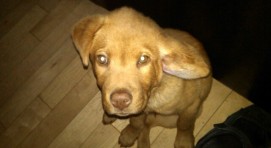
Eye Surgeries
Entropion
Entropion is when either a top or bottom eyelid (or both) is folded inward, causing the eyelashes to rub against the surface of the eye. This can cause pain, squinting and tearing, and can lead to permanent damage of the cornea. Untreated entropion can cause enough damage to the eye for it to eventually become medically necessary to remove it. While any cat or dog can have this condition, it is particularly common in Shar Peis, Chow Chows and Retrievers. It may be present at birth, or it may develop later in life.
Fortunately, there is a surgical resolution for this ailment. If your pet has been diagnosed with entropion, or if you suspect your pet has it, please contact our clinic.
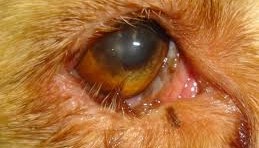
Enucleation
A pet may have endured a certain trauma, or be suffering from an illness, that requires the surgical removal of an eye. This is known as an enucleation of the eye. Most enucleations are performed as a result of an animal having been hit by a car or attacked by another animal, as these violent encounters may have partially forced the eye out of its socket. Advanced glaucoma might also require an enucleation to relieve the pet of pain.
After an enucleation has been performed, the eyelids are shortened, and are then permanently sewn shut.


Cherry eye
A cherry eye is when the inner eyelid gland prolapses, and becomes visible. This can happen in one or both eyes. Cherry eyes are particularly common in Cocker Spaniels, Basset Hounds and Bulldogs. To treat this condition, the gland is tacked back down into place. In some cases, the animal may have one or more re-occurrences of the cherry eye.
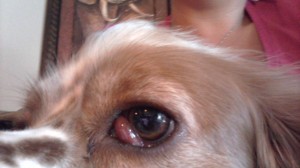
Hernias
Umbilical
Umbilical hernias is a condition in which the abdominal contents protrude through the abdominal wall at the umbilicus (bellybutton). It is seen as a small, perfectly round, jelly-like lump right between the two mammary chains, just below the ribcage. It occurs in both cats and dogs, but is much more common in dogs. Umbilical hernias are typically not a cause for concern, but should be looked at by a veterinarian if the hernia becomes noticeably larger.
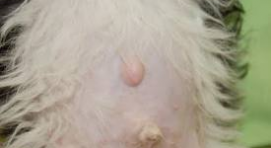
Inguinal
Inguinal hernias are soft masses in the groin area, between the nipples and the leg. They are different sizes, and are considered to be more serious than umbilical hernias.
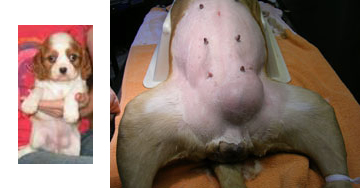
Female-Specific
Vaginal prolapse
Vaginal prolapses are most common in unspayed females dogs. A vaginal prolapsed is when the vaginal wall protrudes through the vulva, giving a pink, donut-shaped appearance. Vaginal prolapses reoccur in females who aren’t spayed, so your pet will be spayed at the time of surgery.
Pyometra
Pyometra is a the bacterial infection of the uterus. This is a relatively common issue in unspayed females, and when it occurs, must be treated immediately. There are three types of pyometra: open, closed and stump. For open pyometra, the most obvious symptom is a discharge of pus from the vulva. For closed pyometra, the dog may be lethargic, have abdominal distention, lethargy and fever. Stump pyometra, a condition that is less common than the others, occurs in the uterine stump left behind in spayed animals.
Male-Specific
Scrotal Ablation
A scrotal ablation is the removal of the entire scrotal sac. When a dog is neutered, the scrotal sac is typically left behind. Since this sac no longer houses the testicles, it eventually shrinks. However, there may be times that the entire scrotal sac may need to be removed, such as if there has been trauma to the scrotum. Neutering an older dog may leave behind a pendulous scrotal sac, so a scrotal ablation is sometimes done at the time the dog is neutered.
Crytorchid
Cryptorchidism is a birth defect in which one, or both, of a dog’s testicles fail to migrate from the body cavity into the scrotum. The condition may resolve itself in young puppies, but if both testicles have not descended to the scrotum by six months of age, it can be assumed that they won’t. If this is the case, the dog should be neutered relatively early, as the incidence of testicular cancer in unneutered cryptorchid dogs is high.
There are two types of cryptorchidism: abdominal and inguinal. In an abdominal cryptorchid, the testicle has been retained in the abdomen, while in an inguinal cryptorchid, the testicle has been retained in the scrotal area.
Masses
Mastectomy
Mammary cancer can occur in both cats and dogs. The most obvious sign that your pet might have cancer is a growth, or a series of growths, along the mammary glands. Mammary tumors are one of the most common types of tumor in dogs.

Debulking
Debulking is when part of a malignant tumor is removed. This is done only if the tumor cannot be removed in its entirety. Debulking should be accompanied by chemotherapy and/or radiation. (The Sam Simon Foundation does not offer chemotherapy or radiation, so if you are considering a debulking, you will need to consult with a board-certified oncologist ahead of time. Also, please note that our clinic will only debulk a tumor on an animal one time.)
Tumors
Tumors are growths that are cancerous. They can appear in many different shapes, sizes, and textures. All masses should be inspected by a veterinarian for analysis.
Lipomas
Lipomas are also called fatty tumors. They are the proliferation of fat cells, which form a growth. Lipomas are particularly common in large dogs, middle-aged dogs, particularly overweight females. If a dog is prone to lipomas, it is possible that s/he has more than one. Each mass should be inspected by a veterinarian as it arises, as it may be something other than a lipoma.
Most lipomas do not need to be removed, but should be re-inspected if they grow quickly in a short period of time, as a very small percentage can become cancerous.
Miscellaneous
Bite wounds
Our clinic can repair many bite wounds. However, this does not mean that you should delay treatment if your pet is in pain, or in danger of hemorrhaging. If your pet has been bitten or attacked by another animal, you should immediately take him to a veterinarian for treatment. Once your pet has been stabilized, then you can contact us for surgical help.

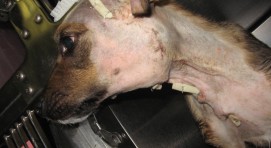
Bladder Stones
Bladder stones can occur in both dogs and cats. Your pet may be urinating more frequently, or urinating throughout the house. The urine might be pink- or red-tinged, or there may be no urine stream at all as your pet strains to urinate. Often the pet seems depressed and doesn’t want to eat. Bladder stones can be incredibly painful, and should be treated immediately.
If you suspect your pet has bladder stones, please visit your regular veterinarian right away. Bladder infections can have the same symptoms as stones, so you need to have your pet evaluated. If your veterinarian suspects stones, and unless s/he can definitely feel them on palpation, you must have x-rays taken before scheduling an appointment with us.
Exploratory
We are limited on the types of exploratory surgeries we can do. If your regular veterinarian has suggested that your pet needs some type of exploratory surgery, please have them submit all the medical records to us, and let us know what the concern is. Exploratories are handled on a case-by-case basis.
Surgeries We Don’t Perform
The description of different conditions and their accompanying photos are to be used only for informative purposes, and not as diagnostic tools. DO NOT diagnose your own pet. If you suspect that your pet has one of the following conditions, either confirm it with your vet or send us a picture. Do not decide against contacting us simply because your pet’s ailment resembles that of one in a picture below.
Anal Prolapse
Anal prolapses in cats and dogs are very painful, and should be treated immediately. An anal prolapse is when the rectal tissue protrudes through the anus, so that it becomes visible. This can be the result of a constipated animal straining to defecate, or can be a symptom of a digestive or other physical disorder.
Back/Disc Surgeries
If your pet is suddenly having trouble going up stairs, or jumping, it is possible that s/he might have a back problem. Please visit your regular veterinarian right away for guidance on what to do. Many dogs suffer slipped or ruptured discs, and surgery should only be performed at a full-service hospital by a board-certified surgeon.
Cataracts
A cataract is when the lens of the eye becomes opaque, giving it a white, cloudy appearance. This is very common in older dogs. While it does not always affect the dog’s ability to see, some cataracts can become so thick, or even slip from the tissue that holds it in place, that they can lead to blindness. Only board-certified veterinary ophthalmologists are qualified to do surgery to correct cataracts.
C-Sections
A Caesarean section is a surgical procedure in which one or more incisions are made through the abdomen and uterus to deliver the young.
Dental Cleanings / Tooth Extractions
Dental health is vital in maintaining the general health of cats and dogs. When teeth aren’t kept clean, bacteria can invade the mouth causing painful abscesses, loss of teeth, and even heart problems. Some animals are genetically prone to poor dental health, while others have simply never had access to dental care. Often, it is necessary to extract teeth to restore the animal to good physical health.
Gastric Obstructions
A gastric obstruction can result from your pet swallowing a foreign object, or from a mass that is growing along the gastric tract. Symptoms of a gastric obstruction might be diarrhea and/or vomiting, constipation, a failure to urinate, loss of appetite and energy, or lethargy. If your pet is exhibiting any of these symptoms for more than 48, take immediately to your regular veterinarian.
Knee Surgeries (e.g., ACL / TPLO / TTA / Cruciate Ligament Repair / Luxating patella)
Knee surgeries can result from injury or can be a result of a birth defect. They can severely limit an animal’s ability to walk or jump, and can be very painful. These injuries should be treated by a veterinarian at a full-service hospital.
Orthopedic Surgeries
Orthopedic surgery is to operate on bone. This may be required when a pet breaks a leg, hip, jaw, or any other bone. Orthopedic surgeries should be performed at full-service hospitals, where the pet can be immediately put into a cage, and hospitalized for an adequate amount of time post-surgery.
Perineal Hernias
A hernia is when an organ protrudes through the wall of the its cavity. A perineal hernia is when either fat, part of the small intestines, the rectum, the prostate, or the bladder bulges through the muscles in the pelvic diaphragm. It often appears as a swelling on one or both sides of the anus. Some causes of this condition include: constipation, excessive straining to defecate, diarrhea, or urinary, prostate or anal sac disease. This occurs primarily in older, non-neutered dogs. The condition can be painful and uncomfortable, and in certain instances, surgery should be done immediately.
Request an FSC appointment
*PLEASE NOTE: Appointments for the FSC are scheduled on a priority basis. Our two most commonly requested appointments are for mass checks and cherry eye repair. If your pet has a mass (aka: growth, tumor) that is not bleeding, you may be waiting several months for an exam, while cherry eye surgery requests might be waiting a year or more. Clear pictures of the injury or ailment, as well as any relevant medical records, can be very useful in our determining your pet’s priority level on our list.
Urgent requests will receive a telephone response within one business day. Non-urgent requests may take up to five business days.
If you are unable to wait for a response or appointment, please click here for a list of other foundations who may be able to help.
The day of your appointment
Once you have been given an appointment, please be advised of the following guidelines:
1. Make sure your pet has something to eat between 8:00pm and 10:00pm the night before surgery.
2. No food after 10:00pm, and no water after midnight. Food and water must continue to be withheld the morning of surgery.
3. Dogs must be walked before coming to the clinic, as they will not be allowed out of the car while you wait for your appointment.
4. You must arrive on time. If you are late, you will lose your appointment.
5. All dogs must be brought on leashes or in a standard pet carrier.
6. All cats must be brought in a standard plastic or cardboard cat carrier. We will not accept cats who are brought in any other type of container, such as a pillowcase, bird cage, regular cardboard box or plastic bin. Only one cat per carrier is allowed.
7. Your pet/s must stay in the car while you check in with our reception staff, and must remain in the car until you are told by a staff member to bring them directly into the clinic. Your appointment will be cancelled if you are seen walking, carrying, or standing around with your pet.
8. Please be patient, as you may be waiting up to two hours until your pet is seen. We do not take animals into the clinic on a first-come, first-serve basis. Rather, the medical staff decides the order of intake each day based on the species, size and sex of the animal, so you may be called right away, or you may be called last. If we cannot find you when we call your name, you will lose your appointment, so we do not suggest leaving the immediate area while you wait.
9. Bring proof that your household income is less than $40,000 per year. Failure to do so will result in the loss of your appointment. A list of acceptable forms of proof can be found here.
10. You will be given your pick-up time the morning you drop off your pet. You MUST return at the exact time you are given. We are a mobile clinic, and we leave at the end of the day. Since we do not have a boarding facility, any animals left at the clinic past pick-up time will be deemed abandoned, and will be taken directly to the local animal shelter.
11. Pick-up time is typically between 2:30pm and 6:30pm, but is subject to change. A staff member will call you if your pick-up time has been moved up or delayed.
PLEASE NOTE: If you are unable to bring your pet to the clinic yourself, the person doing so must bring all of the following documents:
1. A photocopy of your Driver License, state I.D. or passport
2. Proof of your income
3. Either a signed note granting The Sam Simon Foundation permission to perform surgery on your pet while releasing it from liability – OR – download and fill out the Surgical Release Form. (If you are unable to print this out, please review it with the person who is bringing your animal in, so that s/he will be able to answer all the questions accurately. Failure to do so will result in loss of your appointment.)
After your appointment
1. Carefully read and review the post-operative instructions given to you by our staff.
2. Do NOT leave your pet alone until the morning after surgery. Periodically monitor your pet after returning home to ensure its continued recovery after surgery. Furthermore, all dogs and cats must be kept warm and indoors for 24 hours after surgery to help prevent possible complications, or even death, as a result of exposure to outdoor temperature extremes. *Do not take your cat out of the cat carrier before getting home*
3. Because stomach upset can occur after anesthesia, do not offer food or water to pet/s immediately upon returning home. For the first 3 hours, you may give one or two ice cubes to lick or chew on. After 3 hours, you may offer ¼ the normal amount of food, and small amounts of water every 3 hours. You can gradually increase the amount of food and water over the next 24 hours. Return to your pet’s normal feeding routine the following day.
4. Restrict your animal’s activity for 10-14 days after surgery. Do not allow running or jumping. Cats must stay strictly indoors for 10-14 days. Your dog should also stay indoors to allow for optimal recovery from surgery, and should only be taken for short walks on a leash.
5. Check the incision at least twice a day until healed. A small amount of blood seepage is normal right after surgery. If you notice any continued drainage or swelling, call us immediately at the emergency number below.
6. Should the incision become dirty, gently dab the area with a cotton ball and hydrogen peroxide.
7. Do not allow your dog or cat to get wet for at least 14 days after surgery. As such, bathing is prohibited.
8. If the surgery required the use of sutures, the sutures are dissolvable and should not need removal. For cats: use shredded newspaper instead of kitty litter in the litter box for 7 days after surgery to prevent dust particles from irritating the incisions.
9. Unless prescribed by your veterinarian, DO NOT GIVE ANY OTHER MEDICATION to your cat or dog, aside from what we may send home today. Tylenol and aspirin can both be deadly to your pet.
10. If your pet was sent home with a cone (a.k.a. “E-collar”) around the head, do not remove it for 10-14 days, unless advised otherwise by our staff.
11. For all non-emergency questions about your pet’s health, or for emergencies NOT related to the surgery we performed today, contact your private veterinarian or nearest emergency veterinary hospital. To schedule an appointment with our clinic, you may leave a message at 1-888-364-7729.
